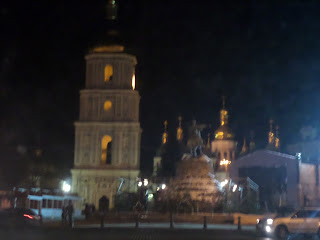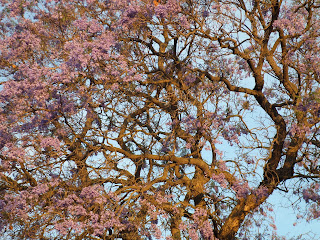Filming
I haven't been able to keep up the blog lately. I've been working on a film. It's about a Professor who searches for truth in Mexico and Cambodia and gets more than he bargained for. I spent most of February and March working on different scripts.
This film project has been about 2 years in the making. In December of 2014 I had the opportunity to reunite with my old friend, Bhakti Sudhir Goswami in Chiang Mai.
It was good to see such a transcendental person. We had some deep talk over organic tea...
And when he had to leave for a preaching tour, he asked the crew to interview me.
I gave a few talks on the old days at Guardian of Devotion Press, and we even filmed some episodes with elephants.
When returning from Chiang Mai and a reunion with Goswami Maharaja in January of 2014, I met with Avadhuta Maharaja in the Bangkok airport. I had bought him a large ceremonial dragon robe in Chiang Mai's night market. He tried it on, but returned it to me, as it made a better fit on me.
He told me he had an idea for a film based on the French explorer who discovered Angkor Wat.
 |
| Angkor Thom |
 |
| Angkor Wat |
 |
| Angkor Wat, drawings by Henri Mouhot |
We talked animatedly about the project, and when I returned to San Miguel de Allende, I began work on the project.
 |
| The young Andres Malraux, 1930 |
I started out with an adventure story based on the life of Andres Malraux, French art critic and war hero who had begun his life as an aristocratic art thief whose attempt to plunder the exquisite bas-reliefs of Banteay Srea resulted in a death sentence, later reprieved. His novel "Path of Kings" gave me some ideas for the story. I finished about 90 pages of screenplay and had it ready by July of 2014.
 |
| Bantei Srea, bas relief |
In July of 2014 I was invited to Russia and Ukraine for the VedaLife festivals sponsored by Avadhuta Maharaja as well as to discuss progress on the script.
 |
| Airport in Kiev, Ukraine. |
 |
| Madhusudan Maharaja, Bhakti Sudhir Goswami, Avadhuta Maharaja, Me, and Bhakti Lalita. |
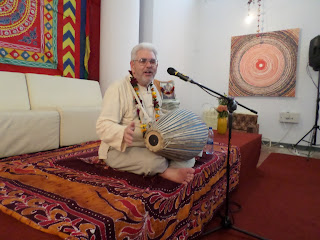 |
| Leading a bhajan at the VedaLife fest. |
 |
| Listening to a conference in Ukraine. |
 |
| Pushkin Park in Moscow |
 | ||
Making Friends in Moscow
|
 |
| VedaLife in Moscow. |
 |
| In Moscow, July 2014 |
 |
| Friends at the Hermitage Museum in Saint Petersburg, Russia |
After discussing the script with Avadhuta Maharaja, much to my chagrin, I discovered that I had misheard Avadhut Maharaja's french pronunciation.
I had mistaken "Andres Malraux" https://en.wikipedia.org/wiki/André_Malraux for "Henri Mouhot." https://en.wikipedia.org/wiki/Henri_Mouhot While Malraux had been famous as an art thief and war hero, Mouhot was from another generation. I had written a great script for an adventure story, but it had nothing to do with Avadhuta Maharaja's idea. So, back to the drawing board.
 |
| Henri Mouhot, a drawing by H. Rousseau based on a daguerreotype photo. |
The story of Henri Mouhot was completely different. Born in the age of colonialism and discovery, he set out to find the lost golden city of Indochina he had read about in obscure books. He is credited with "discovering" Angkor, although in point of fact it was never really lost. While his daguerrotypes are brilliant early examples of photographic art, he never returned to France and his beloved wife Henriette. He died, possibly from complications arising from malaria. Over tea at the GUM in Red Square, Avadhuta Maharaja and I discussed the possibilities of the story. He had a skeleton script worked out. We thought that we might tell the story from Henri's point of view. The film would have a documentary touch, but would have a supernatural element. As Henri succumbed to the fevers of malaria he would have visions of divine reality inspired by the ruins of Angkor and their transcendent mysticism.
Vacation was over and it was back to school. I flew back to Mexico to get back to work.
 |
| At the Ferrero Chocolate Factory in San Jose Iturbide |
Returning to San Miguel, I worked on the script through August and September, balancing the work at the chocolate factory with writing and teaching and had a pretty good working screenplay by October of 2014. I live in the colourful pueblo of San Miguel de Allende. Here's a photo I took outside my window. These are the traditional Aztec dancers.
I liked the idea of a connection between the ancient Mayan and Aztec civilisation of Mexico and the Khmer of Cambodia, so I spent some time visiting the pyramids.
Now, I was becoming an expert on Henri Mouhot, his story, his family, his hopes and dreams. At the same time I had done quite a bit of research on Angkor Wat, the world's largest temple complex devoted to Vishnu, Shiva, and Buddha. Many archeologists were impressed by the similarities between the pyramids of Mexico and the temples of Angkor. http://mexpostfact.blogspot.com/2015/02/the-similarities-between-cambodian.html https://www.youtube.com/watch?v=oN7eNZlA7cw
Avadhuta Maharaja was intrigued by the screenplays I was working on as well as by the work I had done on the Mahabharata for a proposed book. It was time to fly to Russia again and see how we could advance the book. In November of 2014 I was invited back to Russia. I gave some talks in Kiev, Petersburg and Moscow I flew from Mexico City to Cancun, from Cancun to Frankfurt, and then on to Petersburg, where I was met by Prithu Das, my Russian host and travel guide, and by Muralishwar, expert translator and scholar.
 |
| Lahta, Petersburg |
 |
| photo taken out the window of the airplane. I think this is Frankfurt Airport. |

 |
| With Gopa Kishore at the Samurai Exhibit. |
 |
| With Vijay Raman at the Samurai exhibit. |
 |
| A Samurai helmet |
From Petersburg, Prithu and Muralishwar and I rode the Sapspan bullet train, "The Hawk" and traveled at 200 k per hour to Moscow, where we were met by Gokula Taruni the famous Tilak wagon.
 |
| The Tilak wagon. Our urban transportation. |
In Moscow, I was invited to speak again on the occasion of Govinda Maharaja's appearance day. Oddly, the date of his birth according to the solar calendar corresponds to my own. We were both born on December 17th.
 |
| Talk on the occasion of Govinda Maharaja's appearance day in December, 2014 in Moscow. |
 |
| Making new friends. |
 |
| Avadhuta Maharaja's library in Moscow. |
 |
| This is photo is looking out the window of Avadhut Maharaja's quarters in Moscow. |
 |
| Moscow in the rain, December 2014. |
 |
| Waiting for the plane to Ukraine. |
 |
| Muralishwar: translator and scholar. |
 |
| The plane to Ukraine: Aeroflot. |
 |
| Asutosh Krishna and Alakananda DD, also known as Anna Dukhnivska |
 |
| Here's the VedaLife Yoga centre in Kiev. |
 |
| Giving a talk with Asutosh Krishna |
 |
| Friends in Kyiv |
The next day, I flew back to Moscow. It was time to fly to Bangkok and Chiang Mai and finish work on the script before moving on to Angkor Wat, the real reason for the trip.
 |
| Asutosh at the airport in Kyiv |
 |
| LOVE sign at airport in Kiev |
After spending time in the winter snows of Moscow, I was ready for a change.
 |
| Visiting a Buddhist Temple in Chiang Mai |
 |
| With Avadhuta Maharaja, Chiang Mai, December 2014 |
 |
| Working on Mahabharata Project in Chiang Mai with Avadhut Maharaja and Igor Baranko |
 |
| Visiting Buddhist temple in Chiang Mai |
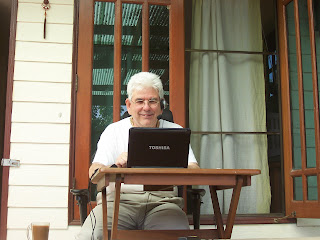 |
| Working on script in Chiang Mai, Thailand |
I had a good script now for the story of Henri Mouhot. Only problem was we don't have any actors. So, we decided to turn it into a documentary. We would go to Angkor and film the different temples and important ruins: Angkor Wat, Angkor Thom, and a dozen different locations. We would shoot a documentary there and later make the film about Henri Mouhot.
So, I put aside the story of the French explorer and began writing about Angkor itself. Being at the Chaitanya Saraswat ashram there gave me a chance to relax in a spiritual retreat and commune with the devotees and truth-seekers who have made it their home.
In the mornings we would hit the books and research the locations we were going to shoot.
The ashram in Chiang Mai sits on a nice piece of land, surrounded by jungle once populated by elephants. The perfect place for meditation...
Or writing. I spent long hours going over the research and creating a workable script for a documentary. I had no idea what lay in store. Filming in Cambodia is not as easy as it looks.
I finalised some details of the script, trying to work out precisely what would happen in each location and come up with a good plan.
Then it was off to Bangkok, and then Siem Reap, Cambodia. By this time I had started this blog, since so many unusual things were happening to me. Here's a few entry from January of 2015... http://mexpostfact.blogspot.com/2015/01/here-i-am-in-siem-reap-people-are.html http://mexpostfact.blogspot.com/2015/01/here-in-siem-reap-internet-connection.html
It wasn't an easy shoot by any means. Along the way, we decided to change the documentary idea and make it into a drama about a team of researchers looking for truth in the temples of Angkor. Gradually that morphed into a different concept. The focus was put on the "Professor" who led the team. It was decided that I would play the part of the "Professor." This took me unawares, since I was happy to play the role of writer and researching. But gradually I got sucked in deeper.
 |
| Arrival in Cambodia at night |
 |
| Film crew with Jana Nivasa, assembling the drone camera |
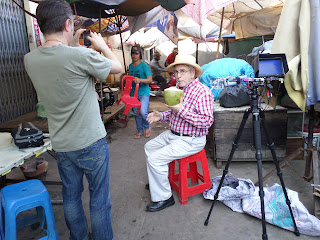 |
| On set at the market in Siem Reap. |
So it was decided to turn me into an actor. I began writing this blog in an attempt to make sense of all the incoherent things going on in my life. Any time I try to describe what's going on, people think I'm just making things up. After this was all done, when I was flying back to Mexico, I was stopped by the immigration and customs authorities at Los Angeles Airport in the United States. They asked me what I had been doing in Cambodia and Russia. When I said, "Well, it's a long story..." I had to do an interview with the inspector. He let me go when I told him, "I'm making a movie with a Russian film producer." The whole thing sounds like a fantasy.
We retraced the route of Henri Mahout, looking for clues to underwater cities sunken for a thousand years. We spent a day out on the Tonle Sap lake, the largest lake in Indochina.
 |
| Crocodile of Tonle Sap |
We visited a war museum which documents the civil wars of Cambodia and the conflicts involving Vietnam, the United States, China, and Russia: a testimony to the savage violence that ripped this peaceful land apart for more than a generation, culminating in the bloody rule of Pol Pot and the Khmer Rouge with the genocide of the killing fields.
 |
| Child soldiers of the Cambodian Civil War |
 |
| Land mines from the museum |
 |
| At Angkor Thom, or Bayon |
 |
| Faces of the Buddha? Or Jayavarman VII, king of Bayon? |
 |
| at Angkor Thom |
We roamed the ruins for a good three weeks, doing our best to stick to the plan in spite of hostile police, inhospitable filming conditions, and some health problems. Avadhut Maharaja pushed on, his faith in the project undaunted by petty difficulties.
While we had made a number of mistakes in planning and executing the film production, it was clear that the men had the ability and talent to create a stunning visual narrative. At the same time, we felt the story was not as clear as we would have liked. Since we had begun by making a documentary some of the dramatic scenes were somewhat improvised, having not been entirely contemplated in the script.
When we filmed in a dry and abandoned rice field, we soon found ourselves surrounded by curious Cambodian children. We handed out some snacks and moved on. In an effort to avoid the corrupt police who had been chasing us out of the ruins and demanding bribes in return for permission to film, we took to the streets...
We rented a jeep and went deep into the countryside, searching for different locations that would fit into the script.
We kept it up for more than 21 days until the entire film crew was exhausted, dusty, worn out, fried by the heat and 10 pounds thinner from the lightweight diet.
In the end, like Roberto Duran who threw up his hands and said, "No Mas," we were done. Out of gas, out of energy, out of time. I had to fly back to Mexico.
A number of plane flights later, I made it from Siem Reap, Cambodia to Bangkok, Thailand. From Thailand to Guangzhou China were I was so dehydrated I searched for water in the airport only to find that a half later bottle was sold at 10 dollars. Parched with thirst I drank from the faucets in the bathroom. From Guangzhou, China, it was a 24 hour flight to Los Angeles, California where Homeland Security questioned me about my trip.
 |
| LAX |
Los Angeles always feels like home, but I still had to make it to Mexico. My brains were toast, my heart palpitating from all the coffee, I was completely wrecked.
Completely silly from jet lag and half-dead, I made it to the airport in Mexico City, where Aurora scraped me up off the pavement and wheeled me across the street to the Ramada Inn. I never slept so soundly.
I had time for a quick game of chess with an old friend...
I had a chance to tend my garden and get back to writing.
Meanwhile, I was invited by a local group of devotees in Morelia to come and give a talk about Govinda Mahārāja.
 |
| In Morelia, 2015 |
Spring came and the Jacaranda trees were in bloom. I spent some time painting...
 |
This is a logo for a foundation for children, "Libros Sin Frontiers," promoting reading in Mexico. |

The devotees from Morelia later invited me to take part in a festival in Celaya, where I had the chance to catch up with my old friend Bhakti Kushum Ashram Mahārāja.
 |
| Ashram Maharaja with Aurora |
Here's a painting of Krishna I did, based on a print by B.G. Sharma.
 |
| My version of Ganesh. |
We began working in earnest on a multi-media project that would include a book, a graphic novel, a video game a film and a theme park. I'm not sure how much of this will become reality, but I felt I could do my best to make it happen and began working in earnest on a summary study of the plot-points as well as some artwork that might be useful in promotion.
Avadhuta Maharaja arrived quietly as promised. We spent a marathon 48 hours discussing every aspect of the Mahabharata from history to philosophy to story and character. I gave him the whirl-wind tour of San Miguel de Allende.
Over tea at the Rosewood, we also worked out a plan that would complete the film. As the script about Henri Mouhot had morphed into a documentary and later a drama, we had lost control of the narrative. We needed a better story, one that would carry the film, perhaps entered around the character of the "Professor." I promised to work on it, along with the Mahābhārata project.
Avadhuta Mahārāja bid goodbye to San Miguel de Allende.
While I had plans to travel to Yucatan to see the pyramids, my health was failing me. All the travel and hard work, stress, the mileage and the years had caught up with me. My heart wasn't getting enough oxygen. Two arteries were blocked in such a way that surgery was impossible. I was in and out of hospitals from San Miguel, to Leon, to Mexico City. The best cardiologist team within 300 miles couldn't help me. The problem was too subtle. Any time I walked more than 100 meters I had chest pains that made me sit down for 15 minutes to rest. My days were numbered. From July of 2015 to November I had to put a lot of projects on hold.
Shri Chaitanya, of course, was not for sale.
Nor was the goddess Saraswati.
But, all in all, I managed to raise enough to cover the costs of the hospital in Mexico City.
 |
| 20 de Noviembre in Mexico City. |
 |
| Ready for the operation |
 |
| Ready for the operation |
 |
| Keeping an optimistic outlook |
 |
| Good news. |
 |
| The doctor's face reflects "cautious optimism" |
I returned to San Miguel de Allende at the beginning of December to rest up from the operation and finish the school year.
With renewed energy, I began studying the Aztec and Mayan cultures in earnest, knowing that it would make for interesting parallels with the Cambodian story. Here I am at the anthropology museum in Mexico City.
 |
| Head of Quetzalcoatl, the plumed serpent, a kind of reflection of the Naga snake gods of Cambodia. |
 |
| Jade Mask of an Aztec King |
 |
| Famous "Toltec Head" |
I knew that soon I would need to rewrite the script, and since the "Professor" is supposed to be a cultural anthropologist I would have to study more about these ancient civilisations. While I'm no expert in an academic sense, I have visited the ruins of Aztec and Mayan pyramids in Oaxaca, Yucatan, Quintana Roo, and Mexico City at Chichen Itza, Uxmal, Monte Alban and Teotihuacan. In addition I have read widely on the subject and have sat for a number of lectures from experts and tour guides. I have a small collection of books including Frederick Catherwood's engravings from "Incidents of Travel in Yucatan." I have traveled from Guatemala to Chiapas and seen various ruins there. I have lived and worked in Mexico for more than twenty years and have visited the local pyramids at La Cañada de la Virgen a number of times. And as far as the ruins of Angkor, I studied a number of books on the subject before visiting the ruins and went through the temples of Shiva, Buddha, and Vishnu throughout the Angkor complex. This in addition to having a number of months on and off in India from the 1970s to the 1990s and studying the Veda literatures in Sanskrit and their commentaries in Bengali. Still I felt I needed more familiarity with the pyramids in Yucatan. I planned another visit.
Aurora and I left in late December of 2015 for Cancun, in Quintana Roo. We visited the Mayan Museum there where we found these descendants of the Naga kings.
 |
| Iguana at Mayan Museum |
 |
| Nagas at Angkor |
 |
| Aurora with Mexican Banyan Tree |
The similarities with Cambodia are not found merely in the strange pyramid like temples of Koh Ker, but also in the vegetation. The very trees of the Yucatan peninsula are close in appearance to those of Cambodia.
 |
| Banyan tree in Angkor Wat. |
 |
| Cambodian Strangler Vines |
Even more unsettling is the similarity between the so-called ¨Shiva¨ temple at Koh Ker and the Mayan pyramids of Mexico. The Koh Ker temple is basically a step pyramid.
 |
| Shiva temple at Koh Ker, Preach Bihear Province, Cambodia. |
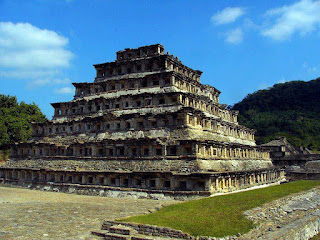 |
| El Tajin Pyramid, Veracruz, Mexico. |
The similarities between the Mayan pyramid found at El Tajin, Veracruz, and the so-called "Shiva temple" of Koh Ker are remarkably striking. At first glance they appear to have been cut in stone by the same hand in the same jungle with the same motifs of serpents and nagas. While El Tajin flourished somewhere between 600 AD and 1200, the important monuments of the Khmer were created between 700 AD and 1170 AD, including Angkor Wat and Bayon or Angkor Thom.
And what of the giant heads found at Angkor Thom? Are they the carved heads of Lokateshwara, the compassionate Buddha? Or as some have suggested, those of the King himself, Jayavarman VII in some kind of massive ego trip?
And do these heads have anything in common with the massive toltec heads of Mexico?
I'm not sure, but I was beginning to feel that my fictional "Professor" character might be able to argue some case for cross-cultural pollination--even if his theories would be dismissed by mainstream archeologists. The problem is these similarities have never really been considered in a serious way. The idea that these far off cultures would have had some means of communication is considered anathema by modern academics. And yet there seems to be some resonance here. Two ancient civilisations separated by thousands of miles of open sea--and yet they both developed pyramids, similar mythologies, striking stone headed figures. If I'm not entirely convinced, at least the character I was developing, the "Professor"of our film, seemed to have some grounds for further academic research.
It was time for a bit of vacation, so we hit the beach.
 |
| At the Beach in Cancun |
 |
| Aurora at the beach in Cancun |
I believe in an organic learning process. By visiting a number of different museums, ruins, and pyramids I have developed a "feel" for the Mayans that cannot be gained by sitting in libraries. As I begin to grow in my understanding I have consulted a number of books on the culture. One of the things that impressed me most about the Mayans was their complete lack of metal tools. They did not know the use of iron or steel, although they worked in gold.
Merida is called the "white city" for the splendour of its architecture. It used to be considered the "Paris" of the Yucatan. Close by are the ruins of Uxmal, a once-proud Mayan City.
Uxmal is much more beautiful than Chichen Itza which is more influenced by the Aztecs and has a more classical architecture. Uxmal is stranger, eerier, and at the same time more intimate. It has the feel of a park.
Uxmal was a centre of Mayan ritual and astronomy for hundreds of years. Why did these people disappear? Perhaps drought? Lack of a water source? Famine? Invasion? The film I'm working on has an apocalyptic theme. Civilisations like the Khmer disappeared in a matter of a few hundred years. The Mayans and Aztecs also vanished within a few hundred years of the conquest. Of course the Mayans still exist underneath a veneer of modern Mexicanism. Some historians place the blame for their decline on biological warfare. The Smallpox virus, Variola Major, was unknown in the Americas before the conquest. It is known that the conquistadores impregnated blankets with smallpox virus to wipe out the local population. smallpox and conquistadores
Whatever the reason for the disappearance of civilisation the question remains what of our own? Are we so different from the cultures and civilisations that preceded us? The Egyptians declined and disappeared before the Romans, and the Mayans and Incas vanished after them. The Khmer rulers built cities that housed hundreds of thousands while London was a tiny village on the Thames. Now only the stones retain their memory. And what of us?
When the oil disappears and the electricity runs out what will become of our digital libraries? Where will the great achievements or our civilisation be stored?
These are some of the questions that we hope to pose with the film we're working on.
Tapanandini was generous with her time and helped us understand not only about the region of the Mayas but also about her personal spiritual odyssey with Govinda Maharaja. She shared her house and heart with us, but in the end it was time to move on. She helped me with a commission to paint a mural at a hotel in Valladolid.
 |
| Contemplating the End of the World |
 |
| Preparing the wall for the mural |
I had painted a series of tango dancers that sold well, so I opted for a mural with a tango dancer motif. The area was to be used as a snack bar, so I felt the the theme worked well with the space.
The Zentik Project is an eco-hotel. All the bungalows are constructed using the mud and wattle technique that was common to the Mayas, but with updated materials. The cottages are cool in the warm tropical climate.
On break from the hard work of painting, I relaxed on the porch to play the ukulele. After the break, we went to visit Chichen Itza, where some of the most important precolombian ruins may be found.
Back in Valladolid I had sketched out the basis for the mural painting in charcoal...
And began blocking in the background.
After a couple of days it started to shape up: a street scene in Boca, Argentina, complete with jaded tango dancers: a gigolo, a tough guy, and a dandy with a few tired musicians.
It took a while to finish the details...
...but in the end the owner was pleased. After a quick tango dance, he offered me and Aurora another week free in the hotel, to be collected on our next visit to Valladolid. But soon it was time to go back home and start the school year.
 |
| On the plane from Cancun |
While at the hotel in Valladolid, I had received a Skype message from Avadhuta Maharaja. He told me I should create a new script this time focusing on the character of the Professor and the idea of the Apocalypse. I liked the idea that the Professor had discovered some kind of link between the Mayan Calendar and their end of the world scenario and pyramid-temples of Angkor. Perhaps the Khmer had seen the end of their civilisation and had tried to warn us. The Professor would put together a team and bring them to Angkor to investigate. His own case was desperate since the doctors only gave him six months to live. I started work on the new script.
It seemed to me that if I gave the Professor character enough of an interesting back-story, the loose dreamlike quality of what we had filmed in Angkor would explain itself.
In the lag-time between working on the script I had written over 700 blogposts to this space, including Stories from the Mahabharata, Reflections, the story of 3 strong Vedic heroines: Shakuntala, Damayanti, and Savitri, as well as a complete translation of the Gaudiya Kanthahara with Sanskrit and Bengali. I had begun working on a rewrite of the Prapanna-jivanamrita as well. But now I sat down with the computer and began in earnest on the Professor's story.
February and March came and went with its attendant rain and cold weather and I spent a lot of time writing and researching. Finally, I got the call from Avadhuta Maharaja: he was sending Indulekha Devi down to help with solidifying the script, consolidating the story, and working out a story board ahead of a possible shoot.
Aurora met her in the airport in Leon, Guanajuato, and within a week I had cut the script I had been working on from 60 pages down to a lean and muscular 21 pages. I had experimented with a number of ideas including a search for the Lost Golden Mask, and another adventure story. Finally, we settled on the idea of a Professor whose days are numbered and his bucket list adventure to discover the lost secrets of Angkor.
 |
| Aurora with Indulekha. |
 |
| A little bhajan. |
 |
| AnantaDev, our sound engineer with Indulekha DD enjoying a tea break |
 |
| Rehearsing in the Jardin of San Miguel de Allende with the "Giano" a local musician |
 |
| With actor friend William Henderson as "The Doctor" |
 |
| Filming in the Desert |
 |
| Devendra Prabhu, our Filmographer and Director of Photography |
 |
| Cast and crew filming at the hospital |
 |
| With Aurora in Pozos |






















